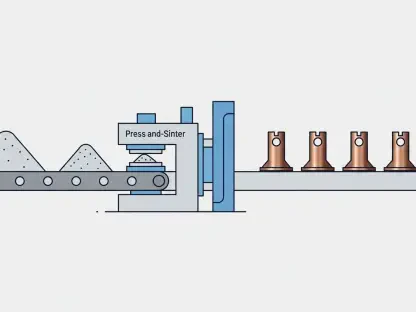In an era where manufacturing drives the backbone of the global economy through innovation, job creation, and trade, the industry faces an unprecedented challenge in safeguarding its digital infrastructure against ever-growing cyber threats. The rapid integration of operational technology (OT) with IT systems, coupled with the explosive growth of Industrial Internet of Things (IIoT) devices, has revolutionized efficiency but simultaneously exposed critical networks to severe risks. Downtime or breaches in this sector don’t just affect a single company—they can disrupt entire supply chains, stalling economic progress worldwide. As connectivity deepens, the urgency to protect these systems escalates, making cyber resilience not a luxury but a fundamental necessity. This article explores actionable, foundational strategies that manufacturers can adopt to fortify their networks against risks, ensuring operational continuity and stability in a landscape increasingly defined by digital complexity.
Unpacking the Cyber Threat Landscape in Manufacturing
The intricate web of modern manufacturing networks presents a daunting hurdle as OT and IT environments converge, amplified by the proliferation of IIoT devices. This fusion, while enhancing productivity, often leaves blind spots in network visibility, creating openings for cyber attackers to exploit. A striking 68% of senior manufacturing decision-makers acknowledge that their IT teams lack the staffing or expertise to manage these sophisticated systems effectively. Such gaps heighten the likelihood of costly downtime and security breaches, with potential consequences extending beyond individual facilities to global trade disruptions. Understanding the depth of these vulnerabilities is crucial, as it lays the groundwork for identifying where resilience must be prioritized to protect both operations and the broader economic ecosystem dependent on manufacturing.
Moreover, the stakes of cyber risks in this industry go beyond mere technical failures, touching on the very reliability of critical infrastructure. A single incident, whether from malware or a targeted attack, can halt production lines, delay shipments, and erode customer trust across interconnected markets. The complexity of managing diverse devices and systems, often spanning multiple locations, compounds the challenge of maintaining control. Many leaders recognize that without a clear picture of their network assets, the risk of undetected intrusions grows exponentially. Addressing this starts with a commitment to transparency and preparedness, ensuring that potential weaknesses are identified and mitigated before they can be weaponized by malicious actors.
Streamlining Operations for Cost and Security Balance
For a significant portion of manufacturing leaders, with 50% citing it as a priority, simplifying network management while controlling costs stands as a critical objective amid digital expansion. As companies increasingly adopt cloud and multi-cloud architectures to support scalability, they inadvertently introduce additional layers of complexity and potential security gaps. Striking a balance between leveraging cutting-edge technology and maintaining straightforward, manageable operations becomes paramount. By focusing on fundamental practices that don’t require exorbitant investments, manufacturers can reduce exposure to threats while aligning with budgetary constraints, creating a sustainable path toward stronger cyber defenses.
This emphasis on simplicity also dovetails with the need to optimize resources in an industry often squeezed by economic pressures. Overcomplicating network setups with unneeded tools or sprawling systems can drain funds and distract from core security needs. Instead, adopting streamlined approaches—such as consolidating management platforms or prioritizing essential updates—helps maintain focus on protecting critical assets. The goal is to build a framework where cost efficiency and security reinforce each other, enabling firms to scale operations into new digital environments without sacrificing stability or inviting unforeseen risks that could undermine long-term growth.
Core Strategies for Network Protection
Building cyber resilience in manufacturing begins with foundational practices, starting with real-time device discovery to gain full visibility into network assets. Knowing precisely what devices are connected, their behaviors, and their internet exposure is vital for both security and operational efficiency. The Cybersecurity and Infrastructure Security Agency (CISA) underscores that maintaining an accurate inventory of assets is a primary step in slashing risk exposure. Without this clarity, vulnerabilities remain hidden, potentially leading to catastrophic failures. Establishing this baseline of awareness allows for quicker identification of threats and supports rapid response mechanisms, forming the bedrock of a resilient network.
Equally critical is the implementation of robust backup and restore capabilities to ensure swift recovery from disruptions like ransomware or natural disasters. Current data reveals a concerning gap—only 20% of network engineers can restore systems within minutes, pointing to a widespread reliance on slow, manual processes. Transitioning to automated solutions can dramatically reduce recovery times, minimizing downtime and its associated costs. This practice not only addresses immediate recovery needs but also builds confidence in operational continuity, ensuring that even in the face of unexpected incidents, production can resume with minimal impact on the broader supply chain.
Enhancing Stability Through Oversight and Upkeep
Another pillar of resilience lies in configuration management, where errors are a leading cause of network outages, with 45% of major incidents tied to misconfigurations, according to the Uptime Institute. Automated checks and compliance tools offer a proactive way to ensure devices adhere to security policies, preventing costly disruptions before they occur. By regularly auditing and adjusting configurations, manufacturers can eliminate common pitfalls that expose systems to threats. This disciplined approach reduces the likelihood of human error and strengthens the overall integrity of the network, safeguarding against interruptions that could cascade through operations.
Lifecycle management also plays an indispensable role, tracking devices from initial deployment to end-of-life to maintain a trusted infrastructure. With 68% of enterprises upgrading devices on a quarterly basis, staying ahead of hardware and software obsolescence is essential for avoiding unexpected failures and budget overruns. Proactive planning for replacements and maintenance ensures that systems remain secure and operational, preventing gaps that could be exploited. This ongoing oversight fosters a culture of preparedness, embedding resilience into every stage of a device’s journey and supporting long-term stability across the manufacturing environment.
Maximizing Impact Through Integrated Approaches
The true power of resilience emerges when individual practices—device discovery, backup and restore, configuration management, and lifecycle tracking—work in unison to create a fortified network. Real-time visibility directly enhances the effectiveness of recovery plans by ensuring all assets are accounted for during a crisis. Similarly, a deep understanding of infrastructure aids in spotting and resolving configuration issues before they escalate into larger problems. This interconnectedness means that strengthening one area inherently bolsters others, creating a robust defense mechanism against cyber threats and operational hiccups.
Centralized oversight ties these efforts together, enabling seamless lifecycle planning and fostering a continuous cycle of improvement. When manufacturers integrate these fundamental strategies, they not only tackle immediate risks but also lay a solid foundation for future security enhancements. This holistic approach transforms isolated fixes into a comprehensive shield, ensuring that networks can adapt to evolving challenges. By embedding these practices into daily operations, the industry can achieve sustained resilience, protecting critical systems while paving the way for innovation and growth in a digitally driven landscape.
Charting the Path Forward for Lasting Security
Reflecting on the journey to cyber resilience, it’s evident that manufacturers have tackled significant challenges by embracing foundational practices to safeguard their networks. Device discovery provided clarity, backup and restore processes minimized downtime, configuration management curbed outages, and lifecycle tracking ensured ongoing reliability. These steps, taken together, formed a powerful cycle of protection that addressed immediate vulnerabilities while preparing for future threats. The focus on simplicity and cost control also proved instrumental, allowing firms to build defenses without overextending resources. Moving ahead, the industry should continue refining these basics, integrating automation and real-time tools to stay agile against emerging risks. Exploring partnerships with cybersecurity experts and aligning with regulatory standards will further solidify this foundation, ensuring that manufacturing remains a resilient cornerstone of global economic stability.









